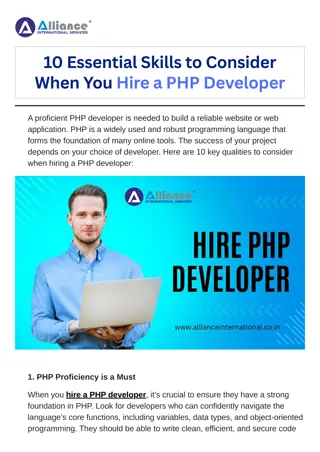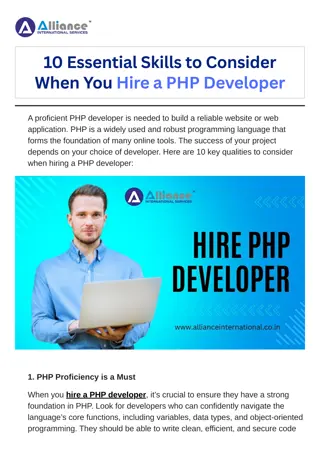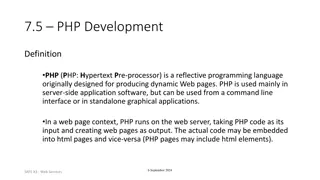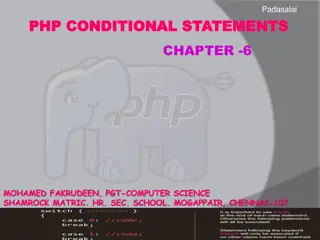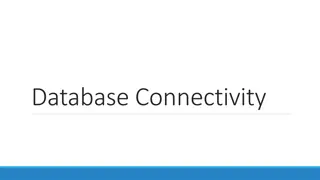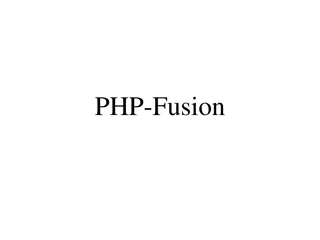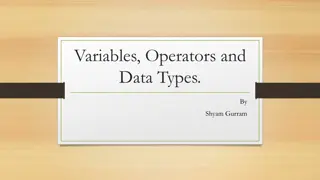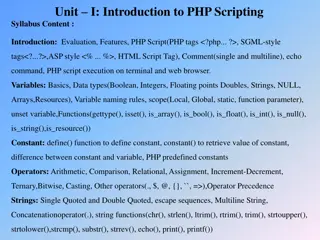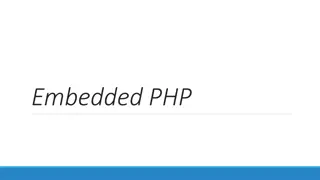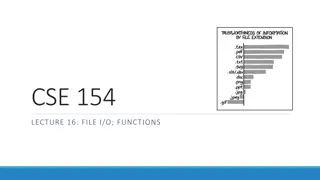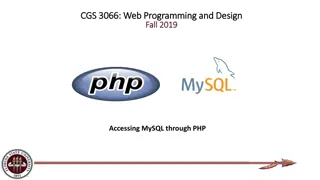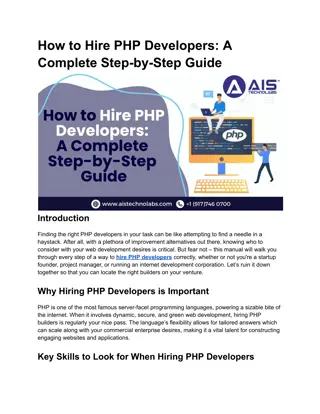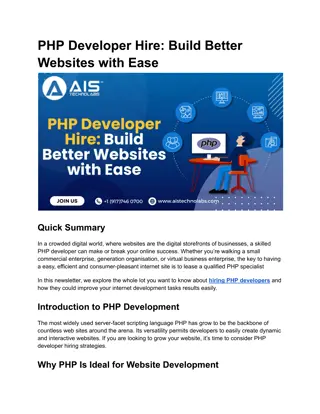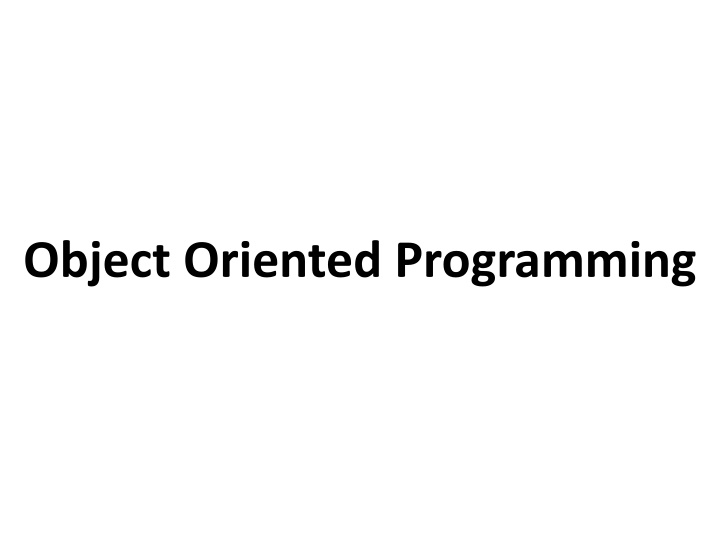
Object Oriented Programming Concepts
Explore the key concepts of Object Oriented Programming, including classes, objects, behavior, data abstraction, encapsulation, cloning, and introspection. Learn how classes serve as templates for objects, how objects interact at runtime, and the importance of abstraction and encapsulation in organizing data and functions. Dive into the world of OOP to grasp the fundamental principles that shape modern software development.
Download Presentation

Please find below an Image/Link to download the presentation.
The content on the website is provided AS IS for your information and personal use only. It may not be sold, licensed, or shared on other websites without obtaining consent from the author. If you encounter any issues during the download, it is possible that the publisher has removed the file from their server.
You are allowed to download the files provided on this website for personal or commercial use, subject to the condition that they are used lawfully. All files are the property of their respective owners.
The content on the website is provided AS IS for your information and personal use only. It may not be sold, licensed, or shared on other websites without obtaining consent from the author.
E N D
Presentation Transcript
Class Class is a software structure that is important in Object Oriented Programming, it is called as a template of an object. Class has data members: Variables & Functions. A class is a collection of objects of similar type. Once a class is defined, any number of objects can be created which belong to that class. Blue print or prototype for an object Contains the common properties and methods of an object Few examples are : Car, Person, Animal
Object Object is an instance of a class. Object gives life to a class. Objects are the basic run-time entities in an object-oriented system. When a program is executed, objects interact with each other by sending messages. For eg. : Ram, Ford and Jimmy are objects belonging to Person, Car and Animal class.
Behavior States Name Parking Model Driving Color Changing Gears No. of Gears Light On / Off Price Washing
Data Abstraction & Encapsulation Abstraction refers to the act of representing essential features without background details or explanations. Classes use the concept of abstraction and are defined as a list of abstract attributes. including the Storing data and functions in a single unit (class) is encapsulation. Data cannot be accessible to the outside world and only those functions which are stored in the class can access it.
Clone Object Cloning is creating a copy of an object. An object copy is created by using the clone keyword. Cloning an object is doing a shallow copy and not a deep copy. $copy_of_object = clone $object;
Introspection Introspection is the ability of a program to examine an object s characteristics, such as its name, parent class (if any), properties, and methods. With introspection, you can write code that operates on any class or object. You don t need to know which methods or properties are defined when you write your code; instead, you can discover that information at runtime.
class_exists() checks whether a class is exists. get_class() returns the class name of an object. Is_object() checks whether a variable is object or not. get_class_vars() returns the default properties of a class get_class_methods() returns the names of the class methods method_exists() checks whether an object defines a method get_declared_classes() returns a list of all declared classes get_parent_class() returns the class name of an object s parent class. is_subclass_of() checks whether an object has a given parent class. interface_exists() checks whether the interface is defined
Object Serialization Serialization is the process of converting some in-memory object to another format that could be used to either store in a file or sent over the network. Deserialization is the inverse process. A PHP array or object or other complex data structure cannot be transported or stored or otherwise used outside of a running PHP script.
Constructor Constructor is a special function in PHP class. It is used to initialize a new object variables. Constructors are called automatically when an object is created. A constructor has the same name as the class. Or PHP provides a special function called __construct() constructor. to define a
__construct constructor. Its better than user defined constructor because if we change class name then user defined constructor method. Note: if predefined constructor and user defined constructor, both define in the same class, then predefined constructor treat like a Constructor while user defined constructor treated as normal method. is known as predefined treated as normal
Destructor Destructors have the opposite function of a constructor. The main use of destructors is to release dynamically allocated resources and to perform other clean up. Like a constructor function you can define a destructor function __destruct(). Destructors are automatically called when an object is destroyed. memory, release using function
Access Modifier Allows you to alter the visibility of any class member (properties and method). Public Access modifier modifier is open to use and access inside the class definition as well as outside the class definition. Protected access modifier : Protected is only accessible within the class in which it is defined and its derived classes. : Public access
Private access modifier : Private is only accessible within the class that defines it. (it can t be access outside the class means in inherited class).
Scope Resolution Operator (::) The Scope Resolution Operator (also called Paamayim Nekudotayim) or in simpler terms, the double colon, is a token that allows access to static, constant, and overridden properties or methods of a class. When referencing these items from outside the class definition, use the name of the class. As of PHP 5.3.0, it's possible to reference the class using a variable. The variable's value can not be a keyword (e.g. self, parent and static).
Static Keyword Declaring class properties or methods as static makes them needing an instantiation of the class. A property declared as static cannot be accessed with an instantiated class object (though a static method can). Static properties cannot through the object operator -> accessible without be accessed the arrow using
Inheritance Inheritance is the process by which objects can acquire the properties of objects of other class. In OOP, inheritance provides reusability, like, adding additional features to an existing class without modifying it. This is achieved by deriving a new class from the existing one. The new class will have combined features of both the classes.
Abstract Class & Methods 5 introduces methods. Classes defined as abstract may not be instantiated, and any class that contains at least one abstract method must also be abstract. Methods defined as abstract simply declare the method's signature - they cannot define the implementation. When inheriting from an abstract class, all methods marked abstract in the parent's class declaration must be defined by the child. PHP abstract classes and
Final Keyword Final Keyword. PHP 5 introduces the final keyword, which prevents child classes from overriding a method definition with final. If the class itself is being defined final then it cannot be extended. Note: Properties cannot be declared final, only classes and methods may be declared as final. by prefixing the
Interfaces Object interfaces allow you to create code which specifies which methods a class must implement, without having to define how these methods are implemented. Interfaces are defined in the same way as a class, but with the interface keyword replacing the class keyword & without any of the methods having their contents defined. All methods declared in an interface must be public. To implement an interface, operator is used. the implements
All methods in the interface must be implemented within a class; failure to do so will result in a fatal error. Classes may implement more than one interface if desired by separating each interface with a comma. Interfaces can be extended like classes using the extends operator. class could not implement two interfaces that specified a method with the same name, since it would cause ambiguity.
Polymorphism Polymorphism means the ability to take more than one form. This word is come from Greek word poly and morphism. Poly means many and morphism means property which help us to assign more than one property. Overloading Same method signature, since PHP overloading concept. Overriding When same methods defined in parents and child class with same signature i.e know as method overriding name with different doesn t support method


